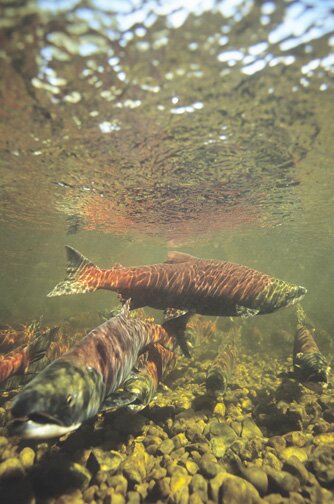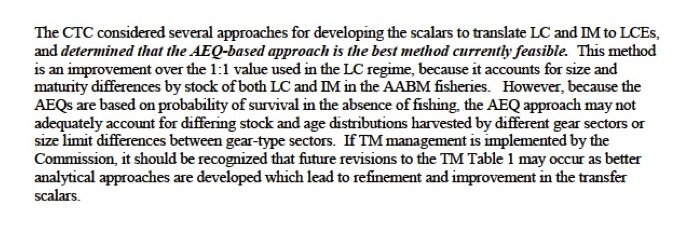A somewhat good news story about sockeye coming out of the Pemberton area near Whistler.
However, maybe mis-guided comments about “co-management”?
The numbers are in from the Lil’wat Nation’s annual sockeye salmon stock assessment for the Birkenhead River. From the time the sockeye entered the river in late August to shortly after the counting fence was blown out by high water levels towards the end of the run in late September, a total of 193,547 sockeye were counted.
“It would certainly be the largest escapement (population) in the last five years,” said Mike Lapointe, head biologist of the Pacific Salmon Commission (PSC). “The previous largest escapement is 2006, which is 266,000, and since then we had 93,000 in ’07, 19,000 in ’08, 54,000 in ’09 and last year, 128,000.”
Typically, 90 per cent of Fraser River salmon have a four-year lifecycle, but the Birkenhead is different in that there can be significant numbers of five- and six-year-olds as well. This is partly related to the fact that it’s a coastal stream and subject to high flash flooding. Because of these fluctuations in the spawning habitat, the populations have evolved to produce more than one age class.
What this means, said Lapointe, is potentially this year’s higher rate of return is because some of the salmon are from 2006.
“With Fraser sockeye, we talk of parent years as being important since they have a four-year lifecycle, then we’d be looking at the escapement four years ago, which was ’07 and that number was 93,000,” he said. “And so for the Birkenhead, it looks like this parent year has produced fairly well.”
But he won’t know how many have returned in 2011 as five-year-olds from the abundant 2006 brood until he examines the samples, said Lapointe.
The Mount Currie Fisheries Program works closely with the PSC throughout the year, closely monitoring conditions of the fish and river.
“Because this is the territory we’ve grown up in and we’re very responsible for, we also document environmental information like temperatures, differences we see in the river and things that catch our eye,” said Maxine Joseph-Bruce, fisheries program manager for the Mount Currie Band.
The collected data is sent to the PSC along with samples — a combination of scales and otolith, the ear bone in the fish. Both have rings on them for determining age, very much like rings that you could see on a tree, said Lapointe.
The annual sockeye count requires the installation of a counting fence across the Birkenhead to create a four-foot wide opening the salmon can pass through. Narrowing the river in this manner facilitates tracking the number of fish swimming upstream.
“We situate a working platform just up-river, about eight feet from the opening, and we count every single fish that swims through that gate,” said Joseph-Bruce.
This year, the counting bench was staffed by two people 24 hours a day, seven days a week — in eight hour shifts — from Aug. 31 through to Sept. 23, when the fence had to be removed due to heavy rain and clogging caused by fallen leaves.
“Kids visit from the local schools, Signal Hill and Xit’olacw, a number of tourists stop in, plus it’s a really positive approach to education and awareness about salmon in our valley,” said Joseph-Bruce. “Some people don’t have a clue that sockeye are returning to the Birkenhead.”
Lapointe added, “The program that Maxine is running is just such a terrific example of the co-management that can occur with the Department of Fisheries and Oceans in terms of having folks that live in the area do the assessments.”
Joseph-Bruce recently attended a salmon ceremony at Pemberton Secondary School and said she would like to see such appreciation for the Birkenhead salmon spread to all local communities.
“They’re aware of this beautiful animal that comes back here… I’m really proud of our youth who are paying attention, and how we in this valley are pretty lucky our land gets fed by these wonderful salmon that return back,” said Joseph-Bruce.
_ _ _ _ _ _
Some great things in this article, and yet some gaping voids…
For example, as Mike Lapointe from the Pacific Salmon Commission mentions, this year’s return of just under 200,000 (to the river) is one of the better returns in several years — e.g, 2006 when the return (to the river) was a little over 250,000 sockeye.
The thing that is so rarely mentioned in any of these numbers…. what was the total run size estimate, before it got hammered by marine, mixed-stock fisheries opened by the Department of Fisheries and Oceans and the Pacific Salmon Commission?
In 2006, for example, the marine exploitation rate (captured in ocean and Fraser mouth fisheries) was almost 30% of the total run size. The total estimated run size for 2006 was almost 600,000 sockeye — before fisheries in Canada’s waters opened on them.
In 2006, just over 175,000 Birkenhead sockeye were caught in fisheries, and a further almost 150,000 were “lost” en route.
_ _ _ _ _
For further comparison, the biggest run prior to that was in 1993 when the total Birkenhead run size estimate was over 1.7 million sockeye.
That year the marine exploitation rate was estimated at 85%: over 1.3 million Birkenhead sockeye caught in marine fisheries on the BC coast in 1993.
Only 245,000 sockeye made it back to the river that year.
So one must gather that the esteemed fisheries science of the last several decades suggests that we can take 85% of a population and expect it to produce the same size run at the conclusion of its life cycle? (4-6 years when it comes to Birkenhead sockeye)
_ _ _ _ _ _
Similar story in 1986.
Total run size for Birkenhead sockeye estimated at over 1.6 million.
Marine exploitation that year = 78% or almost 1.3 million Birkenhead sockeye killed in marine fisheries.
Number of sockeye that actually made it up river to spawn — just over 330,000.
_ _ _ _ _ _
Want to see some real dismal numbers, look at some other years of Birkenhead sockeye. Go back one year further…
1985
Total estimated run size: 144,000
Marine exploitation: 89% which equals, almost 130,000 sockeye caught.
How many made it to the river to spawn?
11,000.
_ _ _ _ _ _
In the year 2000 (after how many public inquires into sockeye issues? 3, 4, 5?)
Total Birkenhead run size estimate: 63,000
Marine exploitation: 65%, almost 43,000 Birkenhead sockeye caught in fisheries.
Total return to spawning grounds: 14,470.
_ _ _ _ _ _ _
The newspaper story says it well.
Typically, 90 per cent of Fraser River salmon have a four-year lifecycle, but the Birkenhead is different in that there can be significant numbers of five- and six-year-olds as well. This is partly related to the fact that it’s a coastal stream and subject to high flash flooding. Because of these fluctuations in the spawning habitat, the populations have evolved to produce more than one age class.
So sockeye populations of various rivers have ‘evolved’ (over eons and changing conditions) to deal with wide-ranging environmental conditions.
Did they evolve to deal with having upwards of 80% of their total returning runs caught in mixed-stock fisheries in the ocean?
No.
They have enough challenges with mud slides (for example in the Pemberton area),
weather events, glacial run-off, spring and fall downpours, and the like, to contend with for simple survival. Let alone misguided fisheries management policies for upwards of 100 years that say, “yeah, go catch 80, 90% of those runs… they’ll be fine.”
The Birkenhead is one of only 19 Fraser sockeye stocks that has sufficient info to track in a year-after-year basis. And like so many other runs, this data is very time limited, the Birkenhead data only goes back into the 1980s.
What about many of the over 200 distinct Fraser sockeye stocks that once existed prior to the beginnings of cannery row in the late 1800s? The many 100s of stocks that had also ‘evolved’ various life strategies and characteristics to deal with local challenges and opportunities.
R.I.P.
… that’s what.
The mixed-stock, Maximum Sustainable Yield (MSY — see free e-book on this site), fishery practices of the last 100+ years sent those runs the way of the passenger pigeon, dodo bird, and wooly mammoth… victims of ‘market sustainability & ecological prioritization.’
_ _ _ _ _
And thus… is counting fish at fish fences and recording river and environmental data: “co-management“?
As in Mr. Lapointe’s: “The program… is just such a terrific example of the co-management that can occur with the Department of Fisheries and Oceans in terms of having folks that live in the area do the assessments.”
Now, I do want to be respectful, as my interactions with Mr. Lapointe have been good ones. He seemed to me, quite a nice fellow. However in attempting to be ‘hard on the problem, not the person’ — last I checked, co-management is about power relations, not “participating in assessments”… (not to take away from the fact that there is participation permitted in this case).
For example, some suggest co-management means:
A political claim by users or community to share management power and responsibility within the state.
Or,
The sharing of power and responsibility between the government and local resource users.
Or,
Power sharing in the exercise of resource management between government agency and a community organization…
Or,
A partnership in which government agencies, local communities and resources users, NGOs and other stakeholders share… the authority and responsibility for the management of a specific territory or a set of resources.
These all come from the book: by Armitage, Berkes and Doubleday put out by UBC Press in 2007. (pg. 3)
_ _ _ _ _ _
When it comes to looking after wild salmon in Canada — I’m not sure that I’m aware of many (or any) effective “co-management” regimes, as in real sharing of “power” and “responsibility”… with First Nation or local settler communities.
Sure there’s funding handed out to count fish and record river temperatures… but true power-sharing? true partnership?
Hmmmm…
And how do we “co-manage” extinct wild salmon runs — such as the many that have disappeared on the Fraser system or up and down the BC coast?
What I am aware of is governments that insist, every time a case of aboriginal rights and title go to the highest courts in the land, vehemently deny that aboriginal rights and title exist.
And there’s one of the main problems… first people’s fishing rights keep having to be wrung through the adversarial and colonially-based legal system.
And the highest courts in the land repeatedly suggest: ‘yes, they do exist [the rights and the title] and everyone return to the negotiating table to figure it out’…
…that ‘power’ and ‘sharing’ thing… figure it out…
It’s not to say there aren’t efforts on these fronts (some of which that evolved from court cases)… just frustrating to see when terms get co-opted and watered down as if thrown into a muddied river in full fall freshet.















